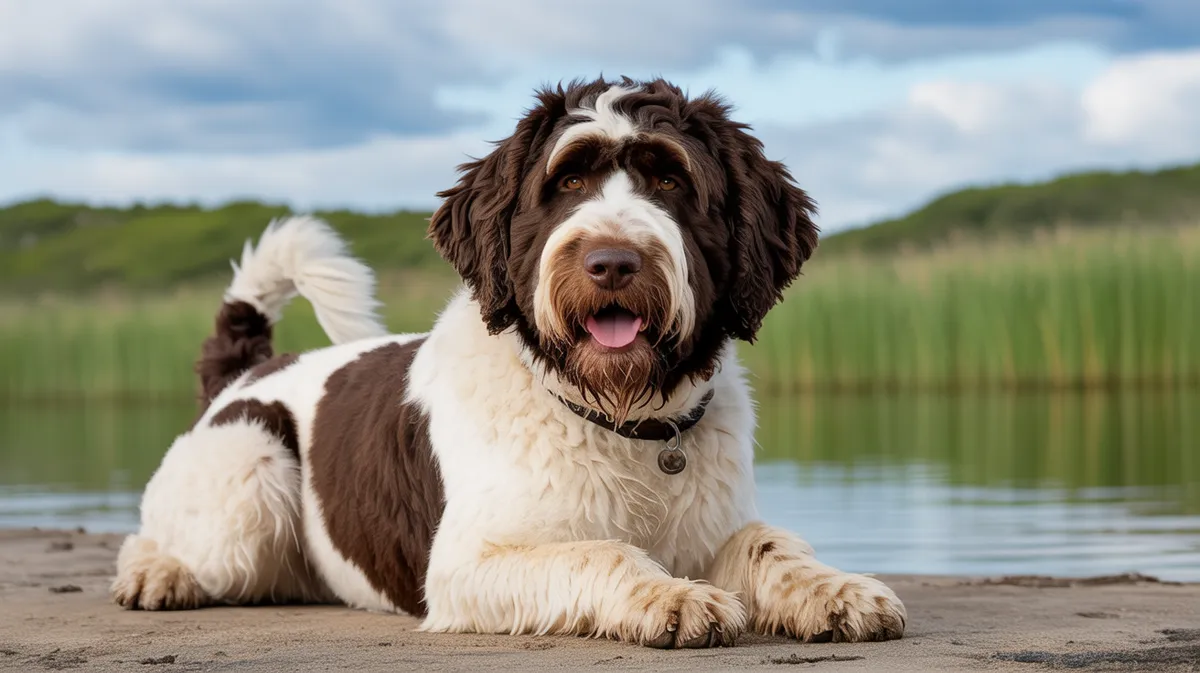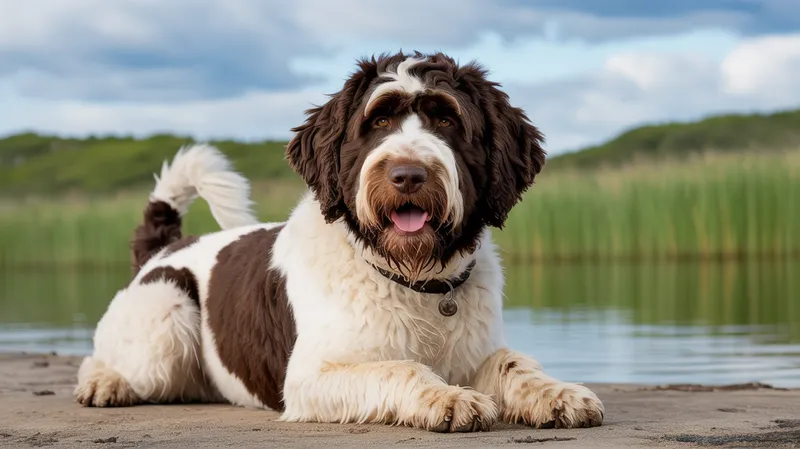
Portuguese Water Dog
Canis lupus familiaris

Meet the Portuguese Water Dog
The Portuguese Water Dog is a highly intelligent and energetic breed originally developed to assist fishermen along the coast of Portugal. Renowned for its swimming ability, this breed has a waterproof, curly or wavy coat and webbed feet, making it an exceptional swimmer. Portuguese Water Dogs were traditionally used for herding fish into nets, retrieving lost tackle, and delivering messages between boats. Today, they are popular as loyal family companions and excel in canine sports and water-related activities. Their playful nature, trainability, and hypoallergenic coat make them a favorite among active households.
Classification
Mammal
Habitat
Coastal regions and human-inhabited areas near water
Diet
Omnivore
Lifespan
10-14 years
Conservation
Least Concern
Weight
35-60 lbs (16-27 kg)
📖Fascinating Facts
Webbed Feet
Portuguese Water Dogs have webbed feet that help them paddle efficiently in the water, making them excellent swimmers.
Fisherman's Helper
Historically, these dogs helped Portuguese fishermen by retrieving nets, collecting fish, and even delivering messages between boats.
Unique Grooming Styles
They are often groomed in the 'lion clip' or 'retriever clip,' both of which have practical origins related to their working history in water.
📋Detailed Description
The Portuguese Water Dog is a robust, medium-sized breed, typically weighing between 35–60 pounds (16–27 kg) and standing 17–23 inches (43–58 cm) at the shoulder. Its most distinctive anatomical features include a dense, waterproof coat that can be either curly or wavy, and well-developed webbing between the toes, both of which are adaptations for aquatic work. The breed's powerful, muscular build and deep chest facilitate strong swimming and diving abilities, enabling it to retrieve objects from considerable depths. Portuguese Water Dogs possess a broad skull, pronounced stop, and expressive, oval-shaped eyes, contributing to their alert and intelligent demeanor. Behaviorally, they are known for their high energy, intelligence, and eagerness to work, making them highly trainable and responsive to commands. Socially, they are loyal, affectionate, and thrive in close contact with humans, often forming strong bonds with family members. They are also known for their playful and sometimes mischievous nature, requiring regular mental and physical stimulation. Reproductively, Portuguese Water Dogs are monoestrous, with females typically coming into heat once or twice a year. Litters usually consist of 4–8 puppies, and both parents may exhibit nurturing behaviors, although maternal care predominates. Unique among canines, their historical role as working dogs aboard fishing vessels has shaped their temperament and physicality, resulting in a breed well-adapted to both land and water environments.
💡 Did you know?
A Portuguese Water Dog named Bo lived in the White House with the Obama family, bringing international attention to the breed.
🔬Research & Sources
Wikipedia Summary
The Portuguese Water Dog originated from the Algarve region of Portugal. From there the breed expanded to all around Portugal's coast, where they were taught to herd fish into fishermen's nets, retrieve lost tackle or broken nets, and act as couriers from ship to ship, or ship to shore. Portuguese Water Dogs rode in fishing trawlers as they worked their way from the Atlantic waters of Portugal to the waters off the coast of Iceland fishing for cod.
Last Modified: 5/27/2025
🎭Behavior & Social Structure
Portuguese Water Dogs are highly active and require substantial daily exercise, including swimming, running, and interactive play. Their historical role as fishing assistants has ingrained a strong work ethic and a propensity for task-oriented behavior. They excel in activities that engage both mind and body, such as obedience, agility, and water trials. These dogs are known for their problem-solving abilities and can be independent thinkers, occasionally displaying stubbornness if not properly engaged. Socially, they are generally friendly with people and other animals, though early socialization is important to prevent territorial or overprotective tendencies. They are vocal communicators, often using barks, whines, or other sounds to interact with humans. Feeding behavior is typical of domestic dogs, with a preference for high-protein diets, but they may exhibit food-guarding if not trained early. Their daily routines benefit from structure, including regular exercise, training sessions, and social interaction to prevent boredom-related behaviors such as chewing or digging.
👶Reproduction & Life Cycle
Portuguese Water Dogs reach sexual maturity between 8–12 months, though responsible breeding is recommended after 2 years of age to ensure full physical and behavioral maturity. The breed exhibits a typical canine estrous cycle, with females coming into heat biannually. Mating is usually preceded by courtship behaviors such as play-bowing and mutual grooming. Gestation lasts approximately 63 days, after which litters of 4–8 puppies are born. Neonates are altricial, requiring extensive maternal care, including nursing, grooming, and thermoregulation. Weaning occurs at 6–8 weeks, and puppies are typically ready for adoption or work training by 8–12 weeks. Breeding programs emphasize genetic health, particularly screening for hip dysplasia, progressive retinal atrophy, and juvenile dilated cardiomyopathy, which are known concerns in the breed.
🛡️Adaptations & Survival
The Portuguese Water Dog exhibits several remarkable adaptations for aquatic environments. Its dense, single-layered coat is both water-resistant and hypoallergenic, reducing drag and insulating against cold water. The breed’s webbed feet enhance propulsion and maneuverability while swimming, and its muscular, tapering tail acts as a rudder for steering. Physiologically, they have a high lung capacity and strong cardiovascular endurance, supporting extended periods of swimming and diving. Behaviorally, their intelligence and trainability are evolutionary responses to the complex tasks required by fishermen, such as retrieving gear and herding fish. Their acute sense of smell and keen eyesight further aid in underwater retrieval and navigation.
🎨Cultural Significance
The Portuguese Water Dog holds a unique place in maritime culture, particularly in the Algarve region of Portugal, where it was historically indispensable to fishermen. It is celebrated in Portuguese folklore and is sometimes referred to as 'Cão de Água' (Water Dog). The breed’s reputation for loyalty, intelligence, and aquatic prowess has made it a symbol of hard work and adaptability. In modern times, the breed gained international prominence when it was chosen as the First Family’s pet during Barack Obama’s presidency, raising its profile and popularity worldwide. The Portuguese Water Dog is also featured in canine sporting events and water rescue demonstrations, further cementing its cultural and functional legacy.
🔬Recent Research & Discoveries
Recent genetic studies have traced the Portuguese Water Dog’s ancestry to ancient water dogs of the Iberian Peninsula, with mitochondrial DNA analyses revealing close relationships to other European water breeds. Ongoing research focuses on the breed’s unique coat genetics, particularly the curly versus wavy phenotypes, and their implications for hypoallergenic properties. Veterinary research has also explored the prevalence and management of breed-specific health conditions, leading to improved screening protocols. Behavioral studies highlight the breed’s exceptional trainability and suitability for service work, including therapy and assistance roles. Conservation genetics efforts are underway to maintain genetic diversity and reduce the incidence of inherited diseases.
🎥Wildlife Videos

Portuguese Water Dog Puppies Nervously Take Their First Bath! | Too Cute!
A litter of Portuguese Water Dogs are being introduced to water for the first time. As their name would suggest, these adorable ...
Animal Planet

Portuguese Water Dog Puppies Dive Into Adventure | Too Cute | Animal Planet
In this episode of ""Too Cute,"" meet the adorable Portuguese water dog puppies, also known as Portuguese fishing dogs.
Animal Planet India

Everything You Need to Know About Portuguese Water Dogs (Part 1)
You've probably seen them on lists of non-shedding dog breeds or even alongside the Obama family, or you're looking for a ...
Talent Hounds

Portuguese Water Dog - Top 10 Facts
Portuguese Water Dog is a super-smart canine companion that once served as crew on fishing trips, retrieving lost gear and ...
Dogs Wiz

Rise Of The Water Dog A Documentary Film
Jared Devin (DevinProductions)
🌍Habitat Information
The Portuguese Water Dog typically inhabits Coastal regions and human-inhabited areas near water environments. Portuguese Water Dogs have adapted to their environments with specialized features and behaviors.
Primary Habitat:
Coastal regions and human-inhabited areas near water
More detailed habitat information will be available soon.
🛡️Conservation Status
The Portuguese Water Dog is currently classified as Least Concern. Conservation efforts are crucial for preserving this species for future generations.
Common Threats:
- 🏠Habitat loss and fragmentation
- 🌡️Climate change impacts
- 🎯Hunting and poaching
- 🏭Human-wildlife conflict
⚠️Threats & Conservation Challenges
Currently, the Portuguese Water Dog is classified as 'Least Concern' in terms of conservation status, with stable global populations due to its popularity as a companion animal. However, the breed faces challenges related to genetic health, including a predisposition to certain hereditary conditions such as hip dysplasia, progressive retinal atrophy, and juvenile dilated cardiomyopathy. Overbreeding and lack of genetic diversity in some lineages can exacerbate these issues. Responsible breeding practices and health screening are essential to maintain population health. There are no significant threats from habitat loss or direct human conflict, but the breed's high energy and exercise needs can result in behavioral problems if not met, sometimes leading to abandonment or rehoming.
🔬Scientific Classification
Scientific Name
Canis lupus familiaris
Classification Hierarchy
🔍 About Taxonomic Classification
Taxonomic classification is a hierarchical system used by scientists to classify and organize living organisms based on shared characteristics and evolutionary relationships.
The system moves from broad categories (Kingdom) to increasingly specific ones, with each animal's scientific name typically consisting of its Genus and species.
📝Community Notes
Share your observations and insights about the Portuguese Water Dog with our community of wildlife enthusiasts.
Join Our Community
Sign in to share your observations and connect with fellow wildlife enthusiasts.
Sign In to ContributeNo community notes yet
Be the first to share your observations about the Portuguese Water Dog!
Explore Portuguese Water Dog
Select a tab above to learn more about this amazing animal.
📸Photo Gallery
No photos available for this animal yet.
🌟Discover More Wildlife
Continue your journey of discovery with more fascinating animals from our database
